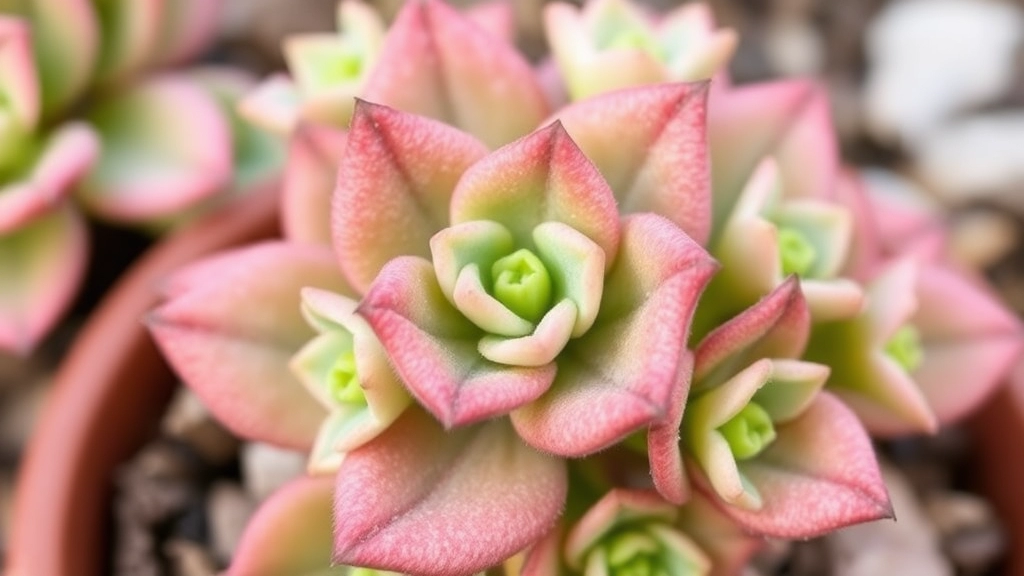Flower Dust Plant: Kalanchoe Pumila
If you’re looking to add a unique touch to your garden, the Flower Dust Plant, also known as Kalanchoe Pumila, is an excellent choice. This succulent is not just eye-catching with its powdery white foliage and vibrant blooms, but also relatively easy to care for. In this guide, I’ll walk you through everything you need to know about growing and maintaining Kalanchoe Pumila, from optimal sunlight exposure to watering schedules and soil types.
Key Features of Kalanchoe Pumila
Understanding the key features of Kalanchoe Pumila is crucial for its proper care. This plant thrives in bright, indirect light and well-draining soil, making it perfect for both indoor and outdoor settings. Regular watering is essential, but it’s important to avoid overwatering to prevent root rot.
Care Tips
- Light: Bright, indirect light
- Soil: Well-draining soil
- Watering: Regular watering, avoid overwatering
Additionally, I’ll share tips on propagation, repotting, and dealing with common pests and diseases to ensure your Flower Dust Plant stays healthy and vibrant year-round.
Key Features of Kalanchoe Pumila
When considering the ideal succulent for your collection, Kalanchoe Pumila, often known as the Flower Dust Plant, stands out.
This charming perennial offers a unique blend of aesthetic appeal and low maintenance, making it an attractive option for both novice and experienced gardeners alike.
Distinctive Characteristics:
- Foliage: Kalanchoe Pumila features soft, silvery-grey leaves with a slightly fuzzy texture. The leaves are oval-shaped and can grow up to 5 cm long, providing a striking contrast against the plant’s vibrant flowers.
- Flowers: This succulent produces clusters of small, bell-shaped flowers that bloom in shades of pink or purple, typically in the spring. The flowers attract pollinators, adding life to your garden.
- Growth Habit: It tends to grow in a compact, bushy form, reaching heights of about 30 cm. This makes it an excellent choice for container gardening or as a ground cover.
- Hardiness: Kalanchoe Pumila is known for its resilience. It can thrive in various conditions, making it suitable for both indoor and outdoor environments. For those interested in similar varieties, you might want to explore the Kalanchoe Beharensis.
For a more comprehensive guide on growing and caring for Kalanchoe varieties, check out our Ultimate Guide to Growing and Caring for Succulent Plant Kalanchoe.
Best Light Conditions for Kalanchoe Pumila
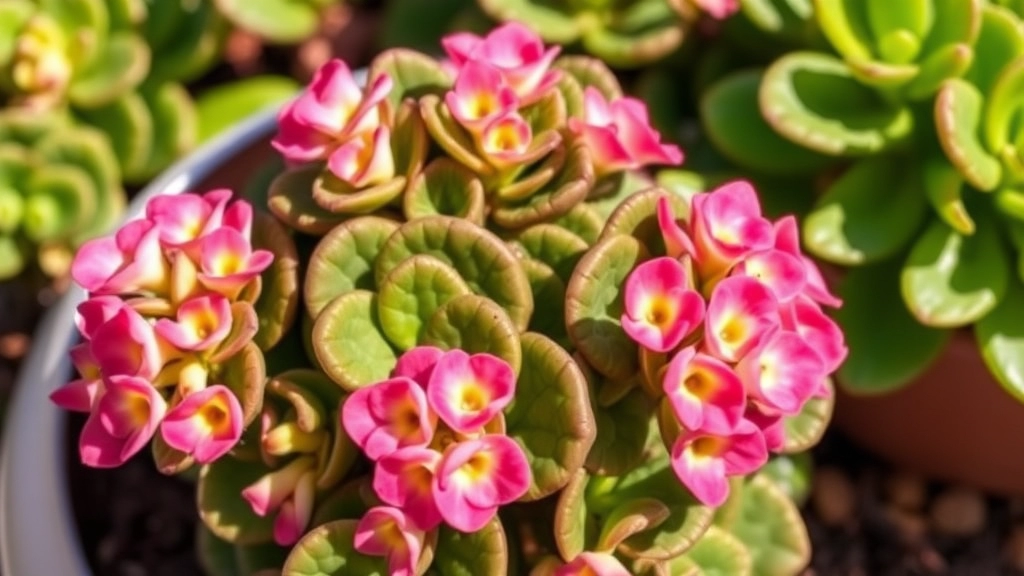
So, you’ve got your Kalanchoe Pumila, and now you’re wondering about the best light conditions for this beauty.
Let’s dive right in!
Bright, Indirect Light is Key
Kalanchoe Pumila thrives in bright, indirect sunlight.
Here’s what you should keep in mind:
- Location Matters: A south or west-facing window is usually perfect.
- Avoid Direct Sun: Too much direct sunlight can scorch the leaves.
- Rotate Your Plant: Every few weeks, give your plant a gentle turn. This ensures even growth and prevents it from leaning towards the light.
Signs Your Plant is Happy
Wondering if your Kalanchoe Pumila is getting the right amount of light?
Look for these signs:
- Vibrant Colour: Healthy leaves should be a rich green.
- New Growth: If you see new leaves sprouting, you’re on the right track!
- Stretching: If your plant starts to stretch or lean, it’s a sign it needs more light.
Adjusting Light Conditions
Sometimes, you might need to tweak things a bit.
- Too Little Light: If it’s not getting enough, consider moving it closer to the window or using a grow light.
- Too Much Light: If the leaves start to look crispy or brown, it’s time to find a shadier spot.
Watering Guidelines for Flower Dust Plant
When it comes to caring for your Kalanchoe Pumila, one of the most pressing concerns is watering. Overwatering or underwatering can lead to a host of problems, including root rot or dehydration. So, how do you strike the right balance?
Understanding Water Needs
Kalanchoe Pumila, also known as the Flower Dust Plant, is a succulent that thrives in arid conditions. Here are some key points to consider:
- Frequency: Water your Kalanchoe Pumila every 2-3 weeks during the growing season (spring and summer). In the dormant season (autumn and winter), reduce watering to once a month.
- Soil Check: Always check the top inch of the soil. If it feels dry, it’s time to water. If it’s still moist, wait a few more days.
- Watering Technique: Water thoroughly until it drains from the bottom of the pot. Ensure you empty the saucer to prevent the roots from sitting in water.
Signs of Watering Issues
Recognising the signs of overwatering or underwatering can save your plant from serious damage:
Choosing the Ideal Potting Soil for Succulents
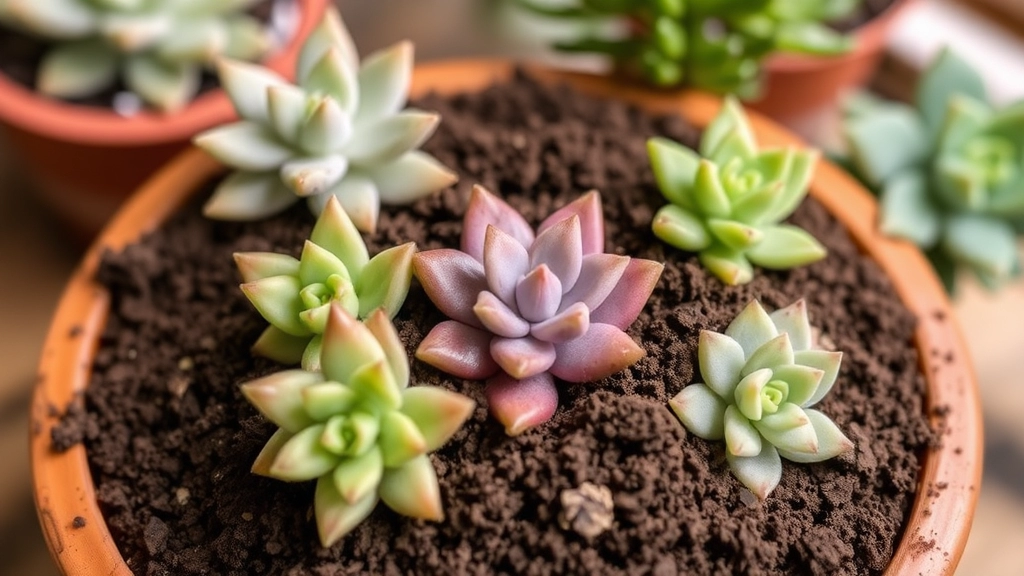
When it comes to nurturing your Kalanchoe Pumila, selecting the right potting soil is crucial. Many plant enthusiasts often wonder: “What type of soil is best for succulents?” The answer lies in understanding the unique needs of these resilient plants.
Why Potting Soil Matters
Succulents, including Kalanchoe Pumila, thrive in well-draining soil. Their roots are susceptible to rot if they sit in moisture. Therefore, a suitable potting mix is essential for their health and growth.
Key Characteristics of Ideal Potting Soil
- Well-Draining: Look for soil that allows excess water to escape easily.
- Aeration: Good air circulation in the soil helps prevent root rot.
- Nutrient-Rich: A slight nutrient boost can support growth, but avoid overly rich mixes.
- pH Balanced: Aim for a slightly acidic to neutral pH (around 6.0 to 7.0).
Recommended Soil Mixes
- Commercial Cactus Mix: Specifically formulated for succulents, these mixes often contain sand and perlite for drainage.
- DIY Mix: Combine equal parts of potting soil, sand, and perlite or pumice. This blend promotes excellent drainage and aeration.
Tips for Choosing Potting Soil
- Check for Additives: Avoid mixes with excessive organic matter, as they retain moisture.
- Consider Your Environment: If you live in a humid area, opt for a mix that promotes even better drainage.
- Test the Soil: Before planting, test the soil’s drainage by watering it and ensuring the excess flows out quickly.
How to Propagate Kalanchoe Pumila Effectively
Are you looking to expand your collection of Kalanchoe Pumila? Propagation is a fantastic way to grow new plants while sharing the beauty of this succulent with friends and family.
Tips for Repotting Flower Dust Plant
So, you’re thinking about repotting your Kalanchoe Pumila, huh? It can feel a bit daunting, but don’t sweat it! Repotting is a great way to keep your Flower Dust Plant thriving. Here are some handy tips to make the process smooth and easy.
When to Repot
- Signs Your Plant Needs a New Home:
- Roots are poking out of the drainage holes.
- The soil dries out too quickly.
- The plant is top-heavy and tipping over.
Choosing the Right Pot
- Size Matters:
- Opt for a pot that’s 1-2 inches larger in diameter.
- Ensure it has good drainage holes to prevent waterlogging.
- Material Choices:
- Terracotta pots are great for succulents as they allow moisture to evaporate.
- Plastic pots can retain moisture longer, so keep that in mind.
Preparing for Repotting
- Gather Your Supplies:
- Fresh potting soil suitable for succulents.
- A clean pot.
- A small trowel or your hands for digging.
- Watering Beforehand:
- Water your Kalanchoe a day before repotting. This helps reduce stress and makes it easier to remove from its old pot.
The Repotting Process
- Remove the Plant:
- Gently squeeze the sides of the pot to loosen the soil.
- Carefully pull the plant out by its base.
- Inspect the Roots:
- Check for any rotten or damaged roots.
- Trim away any unhealthy roots with clean scissors.
- Add Fresh Soil:
- Place a layer of potting soil in the new pot.
- Position your Kalanchoe in the centre and fill around it with more soil.
- Water Sparingly:
- After repotting, wait a week before watering again to allow the roots to settle.
Aftercare Tips
- Light Exposure:
- Keep your repotted Flower Dust Plant in indirect sunlight for a few days.
- Avoid Overwatering:
- Remember, succulents prefer to be on the dry side!
Common Pests and Diseases Affecting Kalanchoe Pumila
As we delve deeper into caring for Kalanchoe Pumila, it’s crucial to address the potential pests and diseases that can threaten its health. Understanding these issues can help you take preemptive measures and ensure your Flower Dust Plant thrives.
How to Prune and Maintain Kalanchoe Pumila
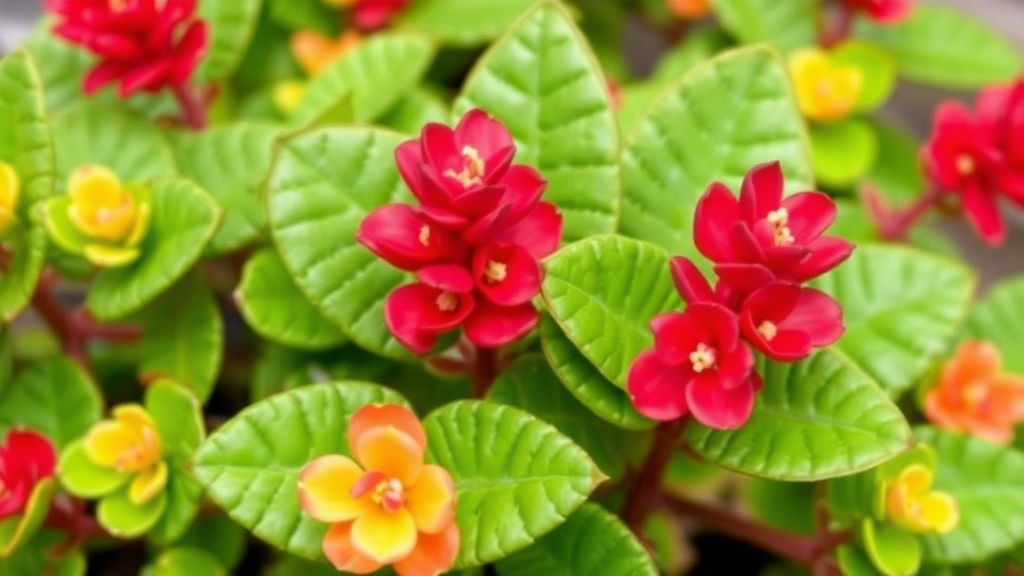
So, you’ve got your Kalanchoe Pumila thriving, but now you’re wondering how to keep it in tip-top shape. Pruning and maintenance are key to ensuring your Flower Dust Plant stays healthy and looks fabulous.
Why Prune?
Pruning isn’t just about aesthetics; it helps your plant grow better.
- Remove Dead Leaves: Snip off any yellow or shriveled leaves. They’re just taking up energy.
- Shape It Up: If your plant is getting leggy, a little trim can encourage bushier growth.
- Promote Airflow: Cutting back overcrowded areas helps prevent pests and diseases.
When to Prune?
Timing is everything. The best time to prune your Kalanchoe Pumila is during the growing season, typically in spring or early summer.
How to Prune?
- Use Clean Tools: Always use sterilized scissors or pruning shears to avoid spreading diseases.
- Cut at the Base: For stems, cut just above a leaf node to encourage new growth.
- Don’t Overdo It: A little goes a long way. Aim to remove about 20-30% of the plant at a time.
Maintenance Tips
Keeping your Kalanchoe Pumila happy involves a few simple practices:
- Check Soil Moisture: Ensure the soil dries out between waterings.
- Fertilize Sparingly: A diluted succulent fertilizer during the growing season can give it a boost.
- Dust Off Leaves: Wipe leaves gently with a damp cloth to keep them clean and photosynthesizing.
Common Mistakes to Avoid
- Pruning Too Much: Over-pruning can stress your plant.
- Ignoring Pests: Keep an eye out for mealybugs or aphids, and treat them promptly.
Maintaining and pruning your Kalanchoe Pumila can feel rewarding, and you’ll be amazed at how quickly it responds.
Encouraging Flower Dust Plant to Bloom Again
Have you ever found yourself frustrated when your Kalanchoe Pumila, also known as Flower Dust Plant, refuses to bloom? You’re not alone. Many plant enthusiasts share this concern, but with a few simple strategies, you can coax those vibrant flowers back into action.
Understanding Blooming Triggers
To encourage your Flower Dust Plant to bloom again, it’s essential to understand what triggers flowering:
- Light Exposure: Ensure your plant receives ample bright, indirect sunlight. Insufficient light can lead to fewer blooms.
- Temperature: Kalanchoe Pumila thrives in warmer conditions. Aim for temperatures between 18°C and 24°C.
- Watering Schedule: Overwatering can hinder blooming. Allow the soil to dry out between waterings to promote healthy growth.
- Fertilisation: Feed your plant with a balanced fertiliser every 4-6 weeks during the growing season. This can enhance flower production.
Seasonal Considerations
- Winter Dormancy: During the winter months, your Flower Dust Plant may enter a dormant phase. Reduce watering and avoid fertilising until spring.
- Spring Awakening: As temperatures rise in spring, resume regular care. This is the ideal time to encourage new growth and blooms.
Pruning for Blooms
- Deadheading: Regularly remove spent flowers to encourage new blooms. This signals the plant to produce more flowers.
- Light Pruning: If the plant becomes leggy, prune back some stems to promote bushier growth and more flowers.
Remember, blooming can take time.
- Observe Changes: Keep an eye on your plant’s growth. With the right care, you’ll soon see those beautiful blooms return. For more tips, check out our ultimate guide to growing and caring for succulent plant Kalanchoe.
If you’re dealing with specific issues like overwatering, our Kalanchoe Tomentosa watering best practices can offer valuable insights.
Indoor vs Outdoor Growth of Flower Dust Plant
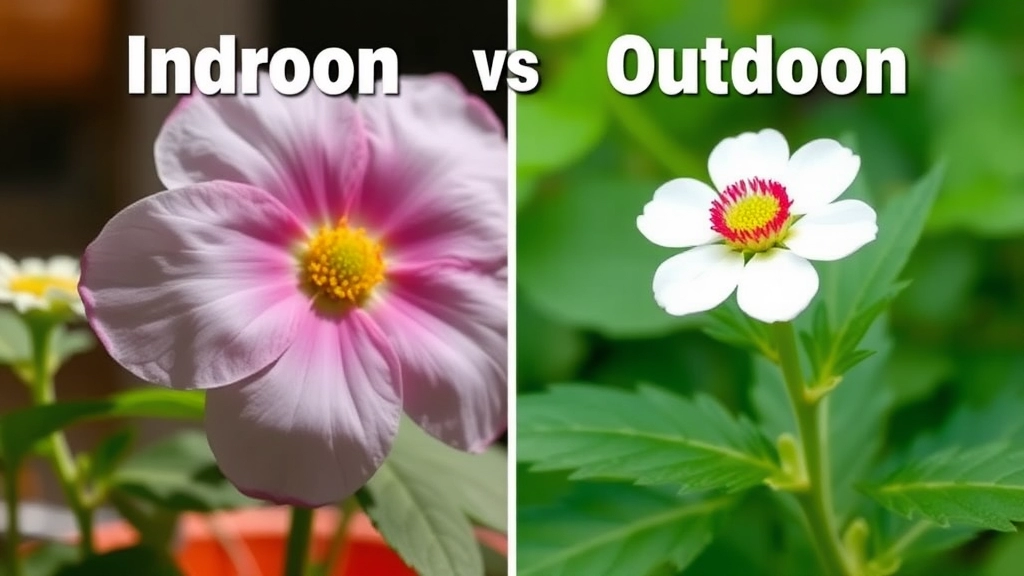
Are you torn between keeping your Kalanchoe Pumila indoors or letting it bask in the great outdoors?
Let’s dive into the pros and cons of each option.
Indoor Growth
Growing Kalanchoe Pumila indoors has its perks:
- Controlled Environment: You can manage light and temperature easily.
- Less Risk of Pests: Indoor plants are often shielded from common outdoor pests.
- Decorative Appeal: They make for stunning houseplants, adding a splash of green to your space.
However, there are some challenges:
- Light Requirements: You need to provide adequate light. A south-facing window is ideal.
- Humidity Levels: Indoor air can be dry, so keep an eye on humidity.
Outdoor Growth
On the flip side, growing Kalanchoe Pumila outdoors can be rewarding:
- Natural Light: They thrive in full sun, which can enhance their growth and blooming.
- Space to Spread: Outdoors, they have more room to grow and establish a healthy root system.
But, there are some things to watch out for:
- Weather Sensitivity: They can be sensitive to frost. If it gets too cold, you’ll need to bring them inside.
- Pest Risks: Outdoor plants are more exposed to pests and diseases.
In my experience, the choice really boils down to your living situation and personal preferences.
If you’ve got a bright, sunny spot indoors, that’s a great option! But if you’re lucky enough to have a warm climate, outdoor growth can lead to a vibrant display.
Signs of Overwatering and Underwatering
Understanding the signs of overwatering and underwatering is crucial for maintaining a healthy Kalanchoe Pumila. These two issues are common pitfalls for many plant enthusiasts, and recognising the symptoms early can save your Flower Dust Plant from serious damage.
Signs of Overwatering
Overwatering is often more detrimental than underwatering. Here are the key indicators:
- Yellowing Leaves: If the leaves start turning yellow, it’s often a sign that the roots are drowning.
- Soft and Mushy Stems: A stem that feels soft or mushy indicates rot, which can spread quickly.
- Wilting despite Moist Soil: If your plant looks wilted but the soil is wet, it’s likely suffering from root rot.
- Foul Odour: A musty smell from the soil can indicate that the roots are rotting.
Signs of Underwatering
On the flip side, underwatering can also lead to distress. Watch for these signs:
- Crispy Leaf Edges: If the edges of the leaves become crispy or brown, your plant may be thirsty.
- Dropping Leaves: Leaves that fall off prematurely can signal that your Kalanchoe Pumila is in need of water.
- Shrivelled Appearance: A plant that looks shrivelled or shrunk is likely lacking moisture.
- Slow Growth: If your plant isn’t growing as expected, it might not be getting enough water.
Finding the Balance
To keep your Kalanchoe Pumila thriving, it’s essential to find the right balance between watering and allowing the soil to dry out.
- Check Soil Moisture: Use your finger to feel the soil. If the top inch is dry, it’s time to water.
- Adjust Watering Schedule: Depending on the season, your watering needs may change. During the growing season, you may need to water more frequently.
For more detailed guidance on taking care of your Kalanchoe, check out our expert tips on Kalanchoe care. Additionally, if you’re interested in learning about the different varieties, don’t miss our Kalanchoe succulent identification guide.
Protecting Kalanchoe Pumila in Different Seasons
So, you’ve got your Kalanchoe Pumila thriving, but how do you keep it safe through the changing seasons?
Spring Protection
As the weather warms up, your Flower Dust Plant will be eager to soak up the sun.
- Gradual Sun Exposure: If it’s been indoors, slowly introduce it to brighter light to avoid sunburn.
- Fertilising: Start a light feeding routine to boost growth. Use a balanced succulent fertiliser.
Summer Care
During the height of summer, things can get a bit tricky.
- Shade is Key: Ensure it’s not in direct afternoon sun to prevent scorching.
- Water Wisely: Increase watering frequency, but always check the soil first.
Autumn Adjustments
As temperatures drop, your Kalanchoe will need some tweaks.
- Reduce Watering: Cut back on water as the plant enters dormancy.
- Monitor Light: Ensure it still gets enough light, but avoid harsh direct rays.
Winter Protection
Winter can be tough, especially if you’re in a chillier climate.
FAQs on Flower Dust Plant (Kalanchoe Pumila)
What are the best light conditions for Kalanchoe Pumila?
Kalanchoe Pumila thrives in bright, indirect sunlight. A south or west-facing window is usually ideal. Avoid direct sunlight as it can scorch the leaves and rotate your plant every few weeks for even growth.
How can I tell if my Kalanchoe Pumila is getting the right amount of light?
Look for vibrant green leaves and new growth. If your plant starts to stretch or lean, it likely needs more light.
What type of potting soil is best for Kalanchoe Pumila?
Succulents, including Kalanchoe Pumila, need well-draining soil. Look for commercial cactus mixes or create a DIY mix with equal parts potting soil, sand, and perlite or pumice.
When should I repot my Kalanchoe Pumila?
Repot your plant when you see roots poking out of the drainage holes, the soil dries out too quickly, or the plant becomes top-heavy and tips over.
What size pot should I use for repotting Kalanchoe Pumila?
Choose a pot that is 1-2 inches larger in diameter than the current one. Ensure it has good drainage holes to prevent waterlogging.
How do I prune and maintain Kalanchoe Pumila?
Prune during the growing season (spring or early summer). Use clean tools to remove dead leaves and shape the plant. Avoid over-pruning and ensure good airflow to prevent pests and diseases.
Is it better to grow Kalanchoe Pumila indoors or outdoors?
Both options have their pros and cons. Indoors, you can control the environment and reduce pest risks, but you need to manage light and humidity. Outdoors, the plant benefits from natural light and space but is more exposed to pests and weather changes.
What are some common mistakes to avoid with Kalanchoe Pumila?
Avoid over-pruning, overwatering, and ignoring pests like mealybugs or aphids. Always use well-draining soil and provide adequate light to keep your plant healthy.
References
-
Kalanchoe Pumila Care: How to Grow the Flower Dust Plant
-
How to Care for a Kalanchoe Plant
-
Kalanchoe: How to Care for Kalanchoe Plants
